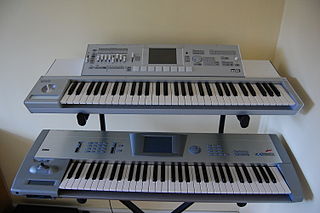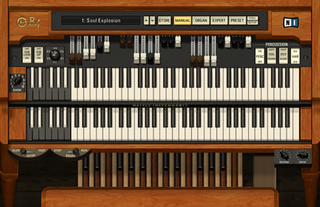
Digital music technology encompasses digital instruments, computers, electronic effects units, software, or digital audio equipment by a performer, composer, sound engineer, DJ, or record producer to produce, perform or record music. The term refers to electronic devices, instruments, computer hardware, and software used in performance, playback, recording, composition, mixing, analysis, and editing of music.

FL Studio is a digital audio workstation (DAW) developed by the Belgian company Image-Line. It features a graphical user interface with a pattern-based music sequencer. It is available in four different editions for Microsoft Windows and macOS.

Cubase is a digital audio workstation (DAW) developed by Steinberg for music and MIDI recording, arranging and editing. The first version, which was originally only a MIDI sequencer and ran on the Atari ST computer, was released in 1989. Cut-down versions of Cubase are included with almost all Yamaha audio and MIDI hardware, as well as hardware from other manufacturers. These versions can be upgraded to a more advanced version at a discount.
Steinberg Media Technologies GmbH is a German musical software and hardware company based in Hamburg. It develops music writing, recording, arranging, and editing software, most notably Cubase, Nuendo, and Dorico. It also designs audio and MIDI hardware interfaces, controllers, and iOS/Android music apps including Cubasis. Steinberg created several industry standard music technologies including the Virtual Studio Technology (VST) format for plug-ins and the ASIO protocol. Steinberg has been a wholly owned subsidiary of Yamaha since 2005.

Virtual Studio Technology (VST) is an audio plug-in software interface that integrates software synthesizers and effects units into digital audio workstations. VST and similar technologies use digital signal processing to simulate traditional recording studio hardware in software. Thousands of plugins exist, both commercial and freeware, and many audio applications support VST under license from its creator, Steinberg.

A digital audio workstation is an electronic device or application software used for recording, editing and producing audio files. DAWs come in a wide variety of configurations from a single software program on a laptop, to an integrated stand-alone unit, all the way to a highly complex configuration of numerous components controlled by a central computer. Regardless of configuration, modern DAWs have a central interface that allows the user to alter and mix multiple recordings and tracks into a final produced piece.

The Korg Triton is a music workstation synthesizer, featuring digital sampling and sequencing, released in 1999. It uses Korg's "HI Synthesis" system and was eventually available in several model variants with numerous upgrade options. The Triton became renowned as a benchmark of keyboard technology, and has been widely featured in music videos and live concerts. At the NAMM Show in 2007, Korg announced the Korg M3 as its successor.

The Yamaha CS-80 is an analog synthesizer introduced by Yamaha Corporation in 1977. It supports true 8-voice polyphony, with two independent synthesizer layers per voice each with its own set of front panel controls, in addition to a number of hardwired preset voice settings and four parameter settings stores based on banks of subminiature potentiometers.
Reaktor is a graphical modular software music studio developed by Native Instruments (NI). It allows musicians and sound specialists to design and build their own instruments, samplers, effects and sound design tools. It is supplied with many ready-to-use instruments and effects, from emulations of classic synthesizers to futuristic sound design tools. In addition, more than 3000 free instruments can be downloaded from the growing User Library. All of Reaktor's instruments can be freely examined, customized, or taken apart; Reaktor is a tool that effectively encourages reverse engineering. The free, limited version called Reaktor Player is a software that allows musicians to play NI-released Reaktor instruments, but not edit or reverse-engineer them.

Waldorf Music is a German synthesizer company. They are best known for the Microwave wavetable synthesizer and Blofeld virtual analogue synthesizer.
The Yamaha TX81Z is a rack-mounted (keyboard-less) frequency modulation (FM) music synthesizer, released in 1987. It is also known as a keyboard-less Yamaha DX11. Unlike previous FM synthesizers of the era, the TX81Z was the first to offer a range of oscillator waveforms other than just sine waves, conferring the new timbres of some of its patches when compared to older, sine-only FM synths. The TX81Z has developed a famous reputation, largely based on some of its preset bass sounds. The Yamaha DX11 keyboard synth was released the following year, offering improved editing abilities.
Arturia is a French electronics company founded in 1999 and based in Grenoble, France. The company designs and manufactures audio interfaces and electronic musical instruments, including software synthesizers, drum machines, analog synthesizers, digital synthesizers, MIDI controllers, sequencers, and mobile apps.

The Yamaha TX16W is a rack-mount sampler sound module made by Yamaha.
Synapse Audio Software is a software company located in Germany. Previously known as Sonic Syndicate and headed by Richard Hoffmann, they develop music production software for the Mac OS and Microsoft Windows platforms. They started developing software in November 1998 as Sonic Syndicate and changed their name to Synapse Audio with the release of Orion Platinum in 2002.

The Yamaha CS2x is a sample-based synthesizer released by the Yamaha Corporation in 1999. The CS2x is designed for maximum real-time control, according to Yamaha. It is the successor of the very successful Yamaha CS1x. Enhancements include 64-note polyphony, a bigger sample ROM, a 24 dB/oct LPF/HPF filter and a two-band EQ per part/layer. The CS acronym stands for Control Synthesizer.

The B4 Organ II is a discontinued commercial, proprietary software synthesizer made by Native Instruments. The software runs as a stand-alone executable, or as a VST, DXi, or RTAS plugin in a Digital audio workstation. The software is an example of a "Clonewheel organ", an attempt at recreating the sound of a Hammond organ using software synthesis.

HALion is a software instrument application, created by German music software company Steinberg for macOS and Windows. It uses a sample-based approach to emulate the acoustic sounds of a full orchestra, such as the strings, brass, woodwind, and percussion sections, with multiple configurations for each instrument, allowing for variations in timbre. It can also use multiple forms of sound synthesis to produce other software synthesizer audio.

Magnus Choir is a commercial, proprietary music software synthesizer, for the Microsoft Windows and macOS operating systems, written by Daniel Laiseca and developed by Syntheway Virtual Musical Instruments. The first version was released in 2005.
The Korg Collection 4 is one of the largest collections of VST instruments from Korg and was released in 2004 with updates and more Synths added over time. The original 2004 release consists of the Korg MS-20, Korg Polysix and Korg Wavestation, and LegacyCell, a VST which layers combinations of any of the past 3 synths mentioned. In 2006, they added the Korg Mono/Poly, Korg M1, and Korg MDE-X Multi FX processor. On December 21, 2017, the ARP Odyssey was made into a VST and added to the collection, and the Korg Triton was added on for Christmas 2019. All of these synths were revamped in the spring of 2020 and renamed, collectively, the Korg Collection 2. With the addition of the Korg Triton Extreme, MiniKORG 700s and Korg Prophecy, it was renamed the Korg Collection 3.
Yamaha Portasound electronic musical keyboards were produced by the Yamaha Corporation during the 1980s and 1990s. The name suggests the instruments' portability, with battery operation being a consistent feature across the line. Many of these keyboards were designed for children with small keys and simple preset functions suitable for educational use. In 1982 the line introduced a card reader system which allowed players to learn and play along with sequenced songs. The PSS line features mini keys and the PSR line features full size keys. Some of the higher-end keyboards have advanced features like programmable synthesizer controls, midi capability, and sampler functions.











